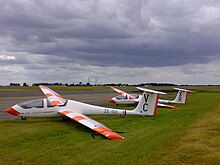No. 614 Volunteer Gliding Squadron RAF
One of 27 Volunteer Gliding Squadrons, it was made up of between 40 and 60 personnel who annually conducted around 6,000 launches, producing more than 800 hours airborne.These schools were formed in the early days of Air Training Corps gliding, and have seen the transition from single-seater primary gliders to two-seater soaring.The early post-war period saw instruction training in Germany by the cream of German gliding instruction, courses at sites such as Dunstable and Great Hucklow, and entries by school instructors into the National Championships where they showed club pilots the skill of ATC instructors in ordinary training machines.In 1974 the RAF left Debden and the base was transferred to the control of the Army in 1975 and the site was renamed Carver Barracks.During 1984 the school was re-equipped with the Grob Viking TX.1, replacing their wood and canvas gliders which was in line with the rest of the Volunteer Gliding Squadron organisation.In 2005, following a decision by the Royal Air Force Board, the VGSs were renamed Volunteer Gliding Squadrons, keeping their VGS acronym.Robertson Barracks, Swanton Morley 2018 - 2022 Following the announcement of the planned closure of MDPGA Wethersfield, a new home was required for 614 VGS.This was found at the former RAF Swanton Morley, now Robertson Barracks, near East Dereham in Norfolk, despite it being due to close earlier than MDPGA Wethersfield.These courses were delivered as part of the Progressive Aviation Training Syllabus, at weekends, and during week nights for the more local cadets.The personnel in the remaining five executive posts have also since changed, this includes the previous Technical Officer Flt Lt Graham Hayes becoming the current Chief Flying Instructor.This was marked with a memorial flight with the longest serving member of 614 VGS Flt Lt Graham Hayes as a passenger.The squadron is then organised into two flights (A & B), these attend on alternate weekends and between them cover the flying during week-long courses.






United KingdomRoyal Air ForceNo. 2 Flying Training School RAFGrob Viking TX.1Volunteer Gliding SquadronNo.22 (Training) GroupRAF Air Commandprimary glidersRAF HendonRAF HornchurchRAF North WealdRAF DebdenCarver BarracksVolunteer Gliding SchoolsRAF WethersfieldNissen hutsBessonneau hangarVolunteer Gliding SquadronsMDPGA WethersfieldLand Rover Defender2012 New Year HonoursLand Rover DefendersLamborghiniSlingsby Sedbergh TX.1Elliotts Primary EoNSlingsby Grasshopper TX.1Slingsby Cadet TX.2Squadron Leader